San Francisco’s Big Bet on The Real World
The city’s latest innovation is curating a sense of place, not AI
Subscribe to get more stories like this one in your inbox.
One of the reasons I wanted to go to San Francisco was to see the city with my own eyes. It’s a great feeling, not needing to triangulate reality from online pictures and videos – it’s just there, in front of you!
And yet, as we visit new places or revisit old ones with fresh eyes, we still try to piece together our understanding of a place based on the signals we receive. Are the storefronts filled? Are the public spaces full of disorder or pro-social behavior? “Trash tells a story,” said Lou Hammonds, Director of Community-Based Public Safety Programs for Urban Alchemy, whom we met at Mint Plaza during the subscriber-only tour in San Francisco last week. It was such an eloquent way of putting it. One of the things Urban Alchemy does is pick up trash because as Hammonds noted, it’s the fastest way to show a community you care.
Urban Alchemy describes its services this way on its website: it heals neighborhoods by employing the unique talents of returning citizens to transform communities and urban spaces. Across 38 blocks of downtown San Francisco, it’s deploying more than 100 people seven days a week who act more like social workers than security guards. It’s working: San Francisco has reported out on Urban Alchemy’s dramatic positive impacts — a 52 percent decrease in crime where their practitioners are stationed.
Lou spent 21 years in prison — the kind of life experience that would disqualify him for certain jobs, but which was an asset in being able to walk some of San Francisco’s most drug-addled streets. And not just monitor these spaces, but build real relationships with the people within them. Lou spoke about building up a kind of emotional “bank account” with the unhoused people lining the streets every day, saying “Good morning,” giving them a cup of coffee or a cigarette, so that when needed he could “make a withdrawal” and negotiate negative behavior.
As we walked through Mint Plaza over to 6th and Market with Urban Alchemy we saw the City’s new pilot: an outdoor drug triage. According to the SF Chronicle:
Operating as a 30-day pilot program, police officers, public health professionals and staff from other city agencies will be stationed at the center to help transport drug users to jail, connect them to treatment or give them a bus ticket to leave town.
Changing the Story of the Arts Economy
There is a different kind of story that CAST— Community Arts Stabilization Trust — is seeking to make. CAST is a self-described community-centered real estate organization committed to ensuring artists and cultural workers can stay anchored where they create. Just around the corner from Mint Plaza, Carolyn Choy, CAST’s Managing Director of Real Estate, met us at the organization’s latest acquisition, 988 Market Street. The organization purchased the 48,313-square-foot former office building for $7.3 million (down from a pre-pandemic worth of $40 million) and is turning it into an arts and media hub, called Warfield Commons.
Local radio station KALW, which came downtown as part of the Vacant to Vibrant program, will occupy two floors, while the other floors of the building will be leased at below-market rates to creative organizations, artists, and cultural workers.
As we walked around offices that once were occupied by VCs, it was thrilling to think about how CAST has flipped the script. So often the arts are given temporary spaces in our cities and used as decoration at public parks. Or they’re confined to art museums, which are grappling with their own declining audiences. Often in the past creatives made fringe neighborhoods safe for mainstream companies, then got priced out of the real estate they’d helped to improve. Now companies that don’t value downtown are being replaced by a new generation of creatives, who this time are owning the real estate, changing who will reap the return on investment.
Putting Place First
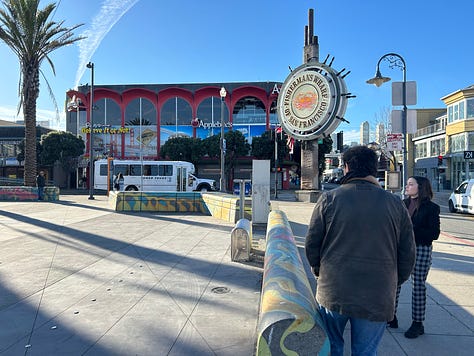
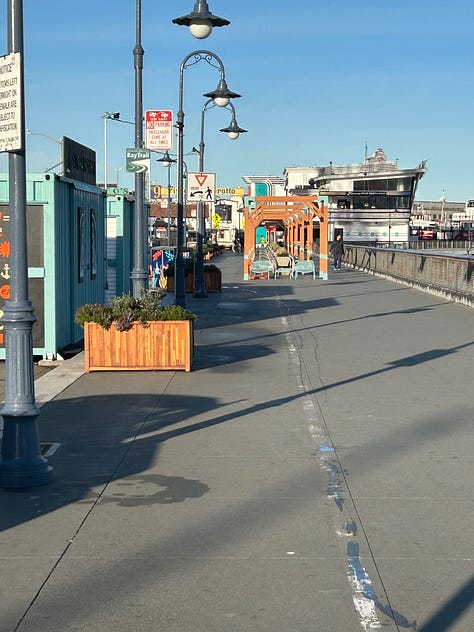
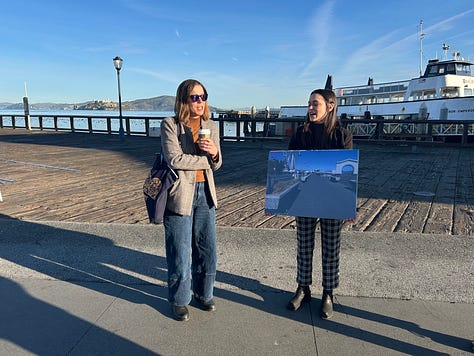
The next day, we met with Julie Flynn of Street Plans, Kaitlin Thresher of Fisherman’s Wharf Community Benefit District (CBD), and Amy Cohen of the Port of San Francisco to explore a new placemaking initiative in Fisherman’s Wharf. One of the city’s well-known and longstanding tourist attractions, the area has seen the closure of many of its large-format seafood restaurants and during the pandemic had also become overwhelmed by unlicensed vendors.
Despite the fresh flow of tourists, the promenade between Pier 39 and the heart of the Wharf on Taylor Street wasn’t that engaging for tourists. Together, the Port, CBD and Street Plans provided a kind of “face lift” freshening up everything: adding planters, repainting street lights, even giving crosswalks a new coat of paint. In addition, they fashioned pergolas that created new spaces for licensed vendors to sell their wares and painted colorful murals to demarcate public plazas where the CBD can host programming, such as concerts. Many of the interventions seemed designed to guide a visitor’s unconscious perception of the Wharf, transforming the sense of a place of faded glory to a contemporary, welcoming spot.
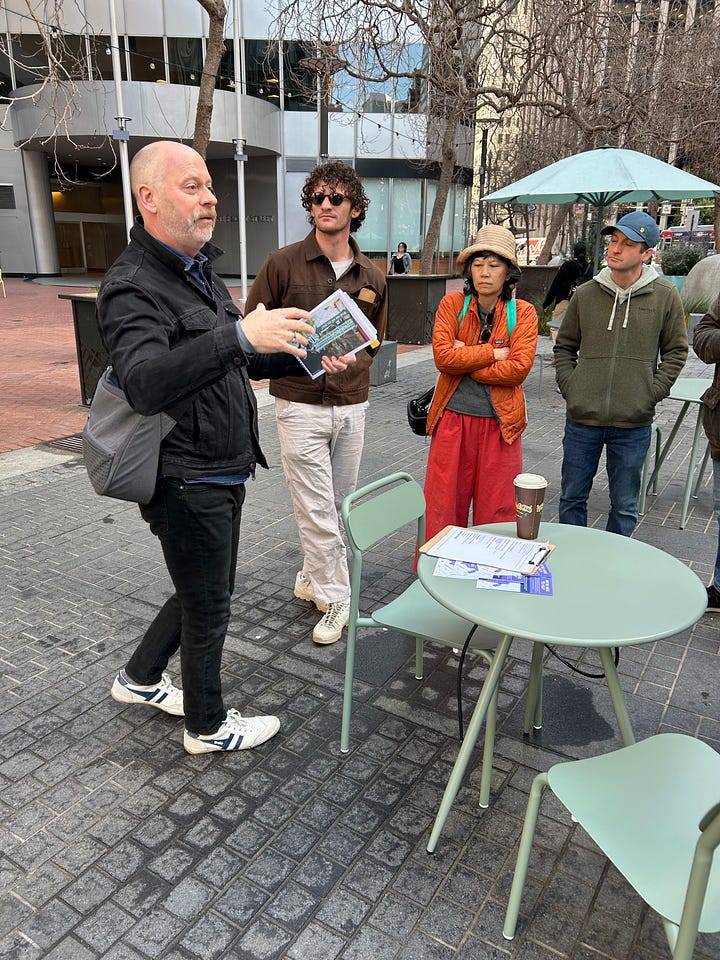
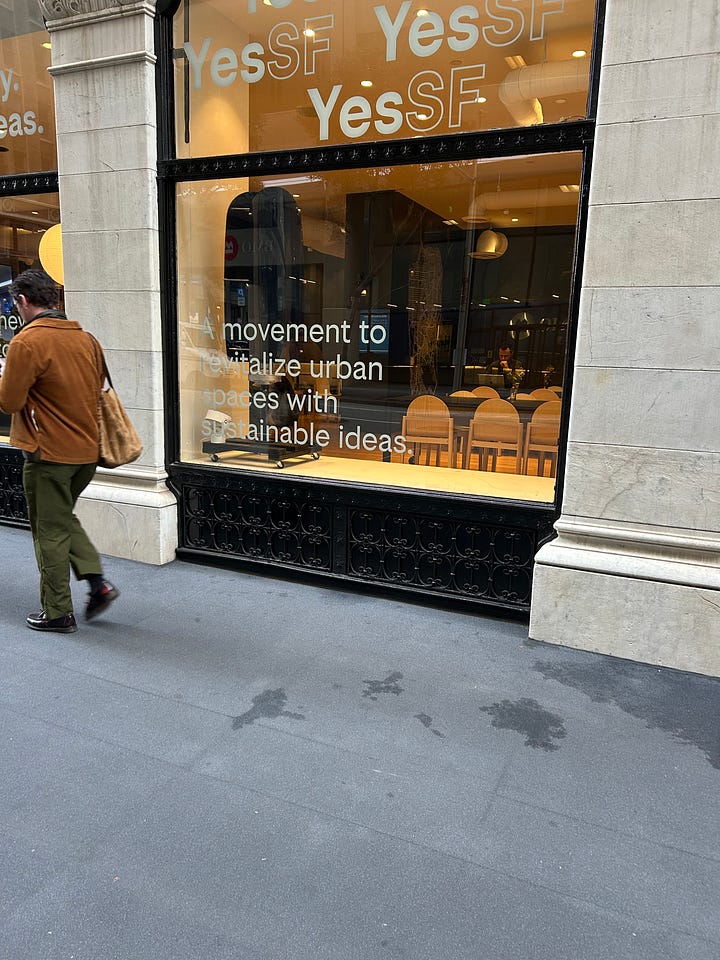
Shortly thereafter we met with Claude Imbault, Deputy Director of Downtown SF Partnership, for a 90-minute tour of downtown. We met at Mechanics Plaza where DSFP cleaned up a graffitied statue, bought some tables and chairs, strung some lights, hoisted a few umbrellas, all demonstrating that until you make the physical aspects of downtown appealing, you’ll never get people to desire to spend time there.
We stopped into the YES SF space, where David Harrison, Director of Public Policy at the San Francisco Chamber of Commerce, talked about how the Chamber, Deloitte, World Economic Forum, and Salesforce partnered to create a combination coffee shop, co-working space and events space in one ground-level storefront. It’s a concept that I worried could feel a bit contrived – kind of like those bank / coffee shops – but it was actually thriving, well-designed, and an ideal place to host an event and get the attention of passersby.
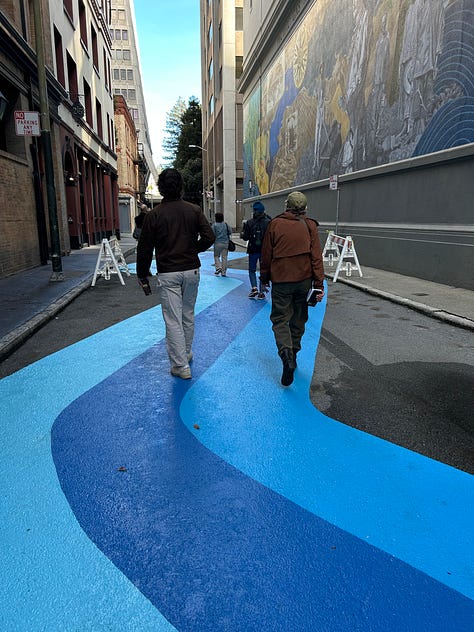
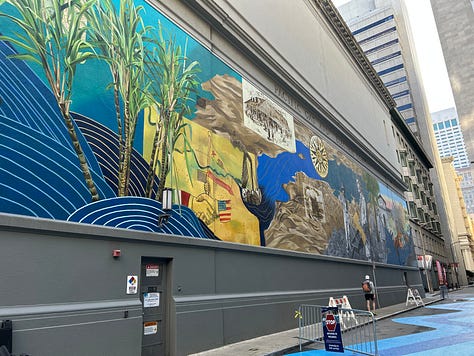

We made it to Leidesdorff Landing, where DSFP commissioned a beautiful mural in honor of Leidersdorff, a Jewish-Black sea captain who was one of San Francisco’s founding fathers. So much of downtown was actually once part of the Bay, as a small mural showed the city’s original coastline. This connection with San Francisco’s history seems like an undervalued part of the experience downtown.
While at Fisherman’s Wharf, the placemaking was reshaping perceptions, here it felt a bit more like the interventions are acting more like a party starter or an ice breaker. The glimmers of art and pedestrianized streets make you wonder a bit more what is around the corner.
Yet, despite the promise of these projects, it’s clear that downtown needs more housing to get the foot traffic needed to sustain businesses if office workers are no longer coming to work. Since the pandemic only one office building conversion has materialized, with just 124 units. Just this week, Mayor Lurie and the Board of Supervisors reached an agreement to “reduce development costs to facilitate these traditionally expensive and complex projects for up to 7 million square feet. It will also extend the application deadline for the Commercial-to-Residential Adaptive Reuse Program, which streamlines approvals by easing zoning and building requirements for office-to-housing conversions.” And there is hope that a proposed “downtown revitalization and economic recovery financing district,” which would allow developers to borrow against future tax revenue to finance construction, will be approved by the Board of Supervisors in the coming months and spur more conversions.
We then walked through Jackson Square, a neighborhood of charming cast-iron buildings and swanky retail that has recently attracted VCs and big name tenants, such as Bain Capital. We learned that Jonny Ive of Apple has bought nearly a block in the neighborhood, which provided a reminder that nothing greases the wheels of development like good ole speculation.
A New Classic
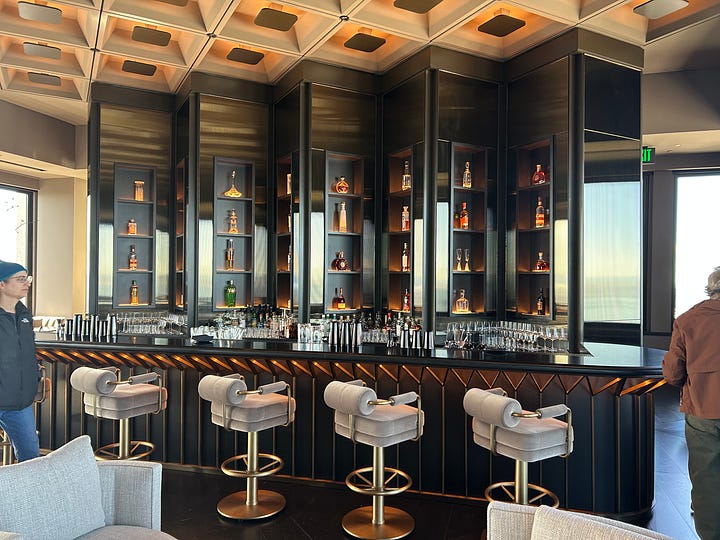

We ended our tour of downtown at the Transamerica Pyramid. Designed by William Pereira, the building was the eighth-tallest tower in the world when it opened in 1972. Critics hated it. Like so many controversial structures, Transamerica became beloved over time. Developer Michael Shvo commissioned architecture firm Foster + Partners to renovate the building, turning a semi-vacant, dated structure into a Class A office tower with ultra-luxury amenities.
We met Kelly Yuen, Associate at Foster + Partners, for a tour of the 48-story building. The renovation feels like a metaphor for the transformation San Francisco right now — making the old look better and new. It’s worth looking at pictures of the building’s before and after to appreciate how much the renovation opened up the lobby. The renovations’s materials, sculptural simplicity, and indoor-outdoor connections all feel classic and permeable. It’s like a magic trick: this big, Brutalist building feels ethereal and light. Even the massive concrete columns look as if you touched them they’d be soft like sand.
The amenity floors match jaw-dropping vistas of mountains, water, ships, and city with posh gym, cafe, and bar. But personally, I preferred being back on the ground where we strolled through the singular Redwood Park, a public park currently enhanced with an exhibition of sculptures by French artists, Les Lalanne.
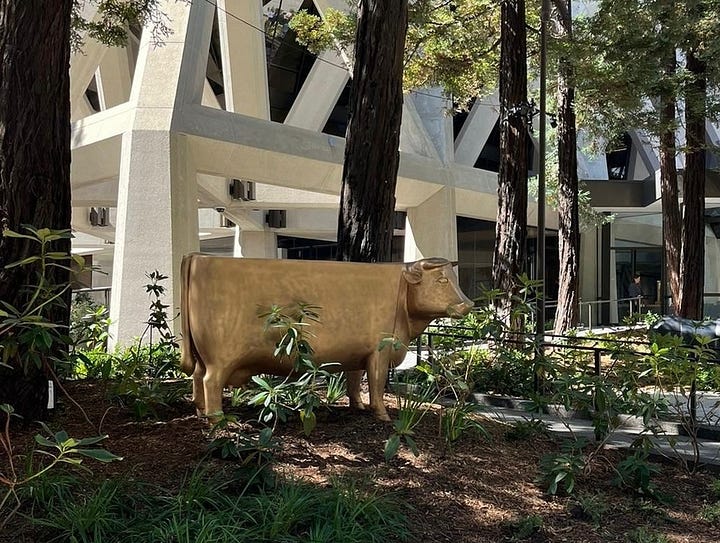
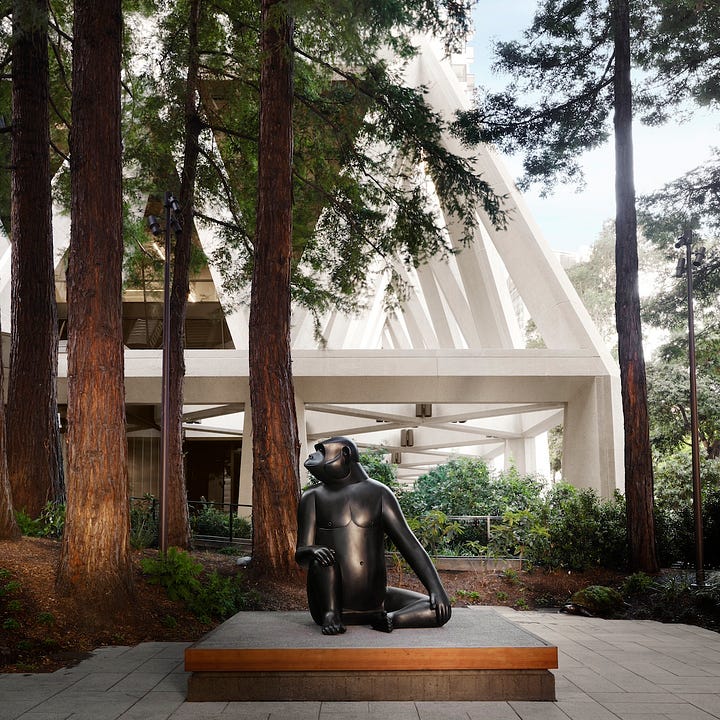
Here Foster + Partners made a few key moves, expanding the park by 1,000 square feet, adding central grove of small trees that counterbalance the 100-foot tall redwoods, a deck providing a space for concerts, and an inviting grouping of lounge chairs. There were some ping pong tables — a nod to the city’s tech workers. Aside from the Waymos and the billboards for AI products, I was surprised by how little I felt the pulse of the tech industry in town. Is it possible that the grand project of San Francisco these days isn’t AI, but rather a citywide rethinking of placemaking?
The city has so many amazing structures and parks that it’s tempting to think when visiting Transamerica Pyramid, Mint Plaza, or the Warfield Building, that “they don’t make them like this anymore.” But all the efforts we toured offered a correction: we’re still in the process of making these places what they are.
This newsletter relies on reader support! Subscribe to get access to extra content, subscriber-only events, the job listings, and to feel good about making this work possible!
Jobs
Detroit Design Center - Co- Executive Director
Freedom Together - Vice President, External Affairs
Banff - Director, Cultural Leadership
Greater Greater Washington - Maryland Policy Manager
Aspen Institute - Socrates Program Coordinator





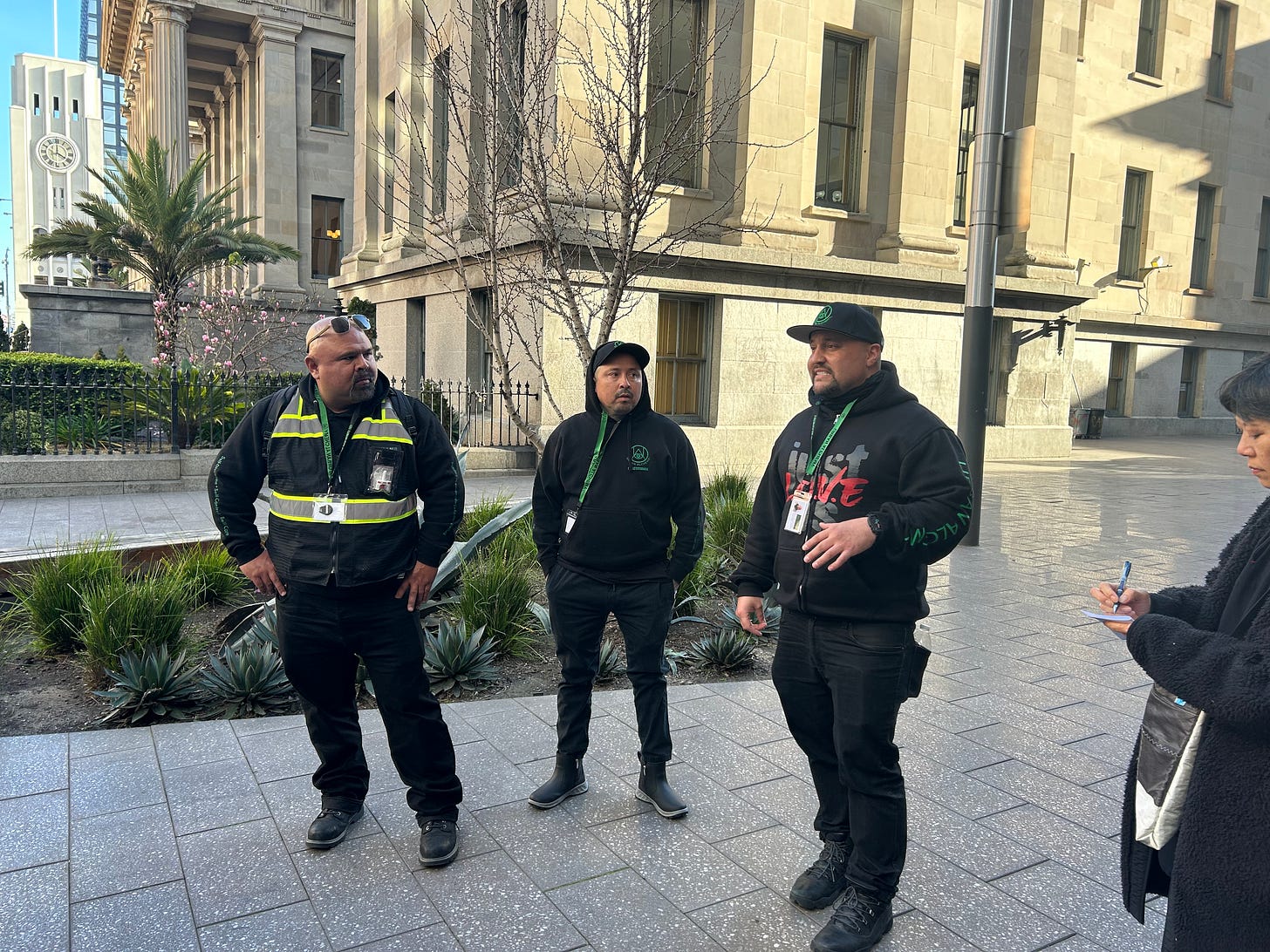

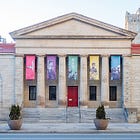
This is a very interesting report and I wish I had found you before I missed the chance to be on the tour! I recently moved from Santa Monica (LA) to Santa Rosa, an hour north of SF, as I'm transitioning to retirement. A new friend (also a retired new arrival) and I take a weekly field trip to experience our new region. In early Feb we spent the day in SF to see the Amy Sherold exhibit at the MOMA and then have dinner at Zuni Cafe on Market Street, taking the Metro between the two sites. The Market Street area was pretty grim, but we did find a coffee shop to hang out in before the restaurant opened, and it was bustling with laptop people. We saw an Urban Alchemy staff member on the Metro, and I explained to my friend what UA does. On a previous field trip we took the SMART train from Santa Rosa to Larkspur and took the ferry to the Ferry Building for lunch.
San Francisco will never solve homelessness until it overcomes the ancient, extensive, expensive barriers to building more housing for everyone. You cannot move people out of the doorways on Market Street if there is no place for them to go. Supply and demand is a law, and I'm seeing it work in Santa Rosa, where barriers to building were lowered when thousands of homes burned in 2017.
Perhaps the new mayor, and the young tech workers who skew to YIMBY, will have the courage to allow new housing in the City. It is one of the jewels of our nation! Thanks for your hopeful report.
A good report. Heartfelt and sincere.
I've spent the better part of 50 years now going to college nearby, working in, and often visiting the city, and while the streets and the rest of the city were in far better shape than most reports give it, I found the Financial District to be far more lifeless than I've ever seen it. And that's because of the historic separation of living and working that the American economy has operated under for the last 100 years. I've worked in those buildings, however, and many of them will be difficult if not close to financially impossible to convert from office to housing, because the work spaces are so deep and because they have central HVAC systems. Further, the Financial District has none of the amenities such as parks, open spaces and plazas that make for good neighborhoods. The streets are designed to get large masses of cars in and out of the city during commute hours, even if those commuters are no longer there. It's possible that the city could simply wait for the office space to lease up again, but that may take ten years and in the meanwhile the buildings will grow old and tired, to say nothing of the loss of activity and tax revenue. If the city wants to turn the area around and make it a truly 21st century place to live and work, it will need to do some massive interventions at the street level, possibly closing some streets altogether and turning them into greenways, and eliminating some of the travel lanes and much of the asphalt on others. It also needs to create a true plan for this area, one that will map out where people go to get outside and shop, where they will see their "neighbors" and work mates, and what will make this a truly exciting place to be. That may require wholesale rezoning to create view corridors, places to sit in the sun and central gathering places. (This was, after all, a place where the great majority of high-rise office buildings went up in a single, 20-year building boom that left little of the original urban fabric.). San Francisco is a world-class city and it can compete with the likes of Shanghai and Singapore and London for world-class talent and business activity, but to do so will require the kind of imaginative intervention that has transformed those cities in the last 40 years.